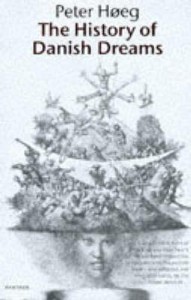 As the title implies, The History of Danish Dreams is dreamlike. Even more so for readers like me who have a poor knowledge of Danish history. Peter Høeg does a masterful job of hovering in the space between fable and fact where story and truth lie and though I am curious about whether there is an underlying structure of verifiable events, I will not look them up because I don’t want the spell to be broken.
As the title implies, The History of Danish Dreams is dreamlike. Even more so for readers like me who have a poor knowledge of Danish history. Peter Høeg does a masterful job of hovering in the space between fable and fact where story and truth lie and though I am curious about whether there is an underlying structure of verifiable events, I will not look them up because I don’t want the spell to be broken.
Part of the spell Høeg casts is that he is able to dance between what happened and what might have happened. This is especially evident as he deals with the young girl Maria and whether she is a model child or the leader of a gang of truants.
The Model Child
The reader already knows much about the strangeness of Maria’s parents by the time she is born. Høeg weaves information about her upbringing into her parents’ narrative and I got to know her before I realized that she too would become an important character.
Over a series of twenty pages I watched Maria grow into an unusually observant child with a stammer. I saw the conditions of her mother’s declining health and the contemporaneous decline of her neighborhood. I learned that she was close with her father. And then there is a brutality that Høeg mentions more than once without delving into. She is different, but still he calls her “the model child.”
Stepping Out of the Narrative
“From this point onward certain problems arise in writing Maria’s story: I would like to depict her as a coherent individual…but this proves to be impossible…History is always an invention; it is a fairytale built upon certain clues…These clues are pretty well established; most of them can literally be laid on the desktop…But these, unfortunately, do not constitute history. History consists of the links between them, and it is this that presents the problem…In the case of Maria Jensen…it is not possible…to cover all the gaps, not even roughly.” – Peter Høeg, The History of Danish Dreams
Høeg interrupts the fictional dream and begins telling two stories—the story of Maria as her parents know her and the story of a second child called “The Stutterer” who could well be Maria. The only link between the two stories is a series of what must be truancy letters from her school. Truly compelling are the strong yet unprovable parallels between Maria and the Stutterer.
As Høeg tells more and more stories of the gang Maria is ostensibly the head of, he continues to use phrases like “It has not been possible for me to have a word with any of the individuals who then belonged in this group” and “we have no witnesses.” Had Høeg laid out evidence that Maria was the Stutterer, the story would have been about a girl who went bad and her parents never even knew. Because Høeg focuses on the gaps, though, and allows for the ambiguity, the story becomes a legend.
By the time Høeg finishes young Maria’s tale, the seven- or nine-year-old (we don’t even know her actual age) Maria has become the Keyser Söze of Denmark. Høeg seems in awe of her. The extent of her exploits could only be understood in the kind of exaggerated rumor that conveys the fullest truth possible but could never be understood in something as rigid as a court of law.
I am interested in exploring the ambiguous experience of a character in the novel I am working on now. I have been looking for a way to convey contradictory yet complementary information. I’m not sure yet if I want to pull the metafictional card by interjecting as a narrator, but I have a lot to learn from Høeg in terms of opening up the story to create a richer experience.
As with any book I read in translation and love, I know some of the credit is due to the translator. My thanks to Barbara Haveland for allowing me access to this book.
If this review made you want to read the book, pick up a copy of The History of Danish Dreams from Bookshop.org. Your purchase keeps indie booksellers in business and I receive a commission.





Leave a Reply